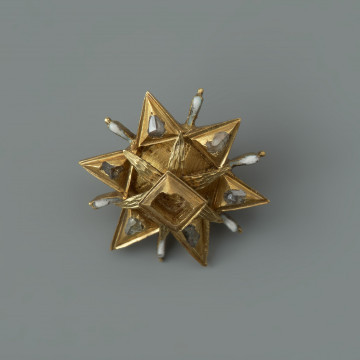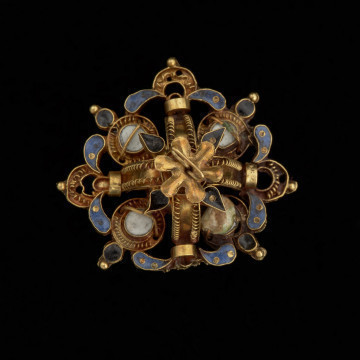
Star-shaped dress jewellery
nie po 1637
National Museum in Szczecin
Part of the collection: Jewels and costumes of Pomeranian dukes
The motif of clasped hands has been used in engagement and wedding jewellery since the Middle Ages as an element decorating rings and clasps. During the wedding ceremony, the bride and groom shook hands as a sign of their marriage vow. The motif of hands referred to this gesture and was a symbol of an unbreakable marriage knot. The presented ring was excavated from the sarcophagus of the Pomeranian Duke Franciszek I from the crypt of the Griffin family under the Castle Church in Szczecin in 1946. The Duke probably received it as a present on his marriage with the Saxon Princess Sophia, sister of the Saxon electors from the House of Wettin, Christian II (1583-1611) and John George I (1585-1656). The marriage took place thanks to the involvement of Erdmutha of Brandenburg, a widow of the Pomeranian Duke John Frederick, Princess Sophia being her niece. The formal wedding took place in the summer of 1610 in Dresden. Thanks to Francis I's posthumous image in the collection of the Cathedral in Merseburg and the description of the Duke's attire in the commemorative prints celebrating his funeral ceremony, we know that the ring was initially decorated with a 'large, costly' diamond of plaque cut. The Duke wore it on his left index finger. The lower part of the stone setting is covered in black enamel with a delicate gold ornament made in the groove enamel technique. The outside of the ring is similarly decorated. The rings with a single large diamond decorated with black enamel were popular in the 1st half of the 17th century. This type of ring was found, for example, in the sarcophagus of the Pomeranian Duke Ernest Bogislav von Croy (1620-1684). It belonged to his mother, Anna of Pomerania (1590-1660), the youngest sister of Duke Francis I.
Monika Frankowska-Makała
Author / creator
Dimensions
cały obiekt: height: 2,8 cm, width: 2,5 cm
Object type
ring (jewellery), jewellery
Creation time / dating
Creation / finding place
Identification number
Location / status

nie po 1637
National Museum in Szczecin

nie po 1637
National Museum in Szczecin

około 1600
National Museum in Szczecin
DISCOVER this TOPIC
National Museum in Lublin
DISCOVER this PATH
Educational path